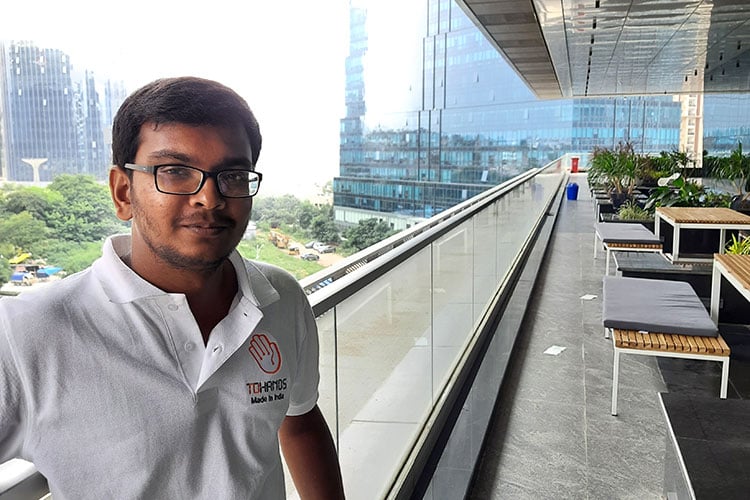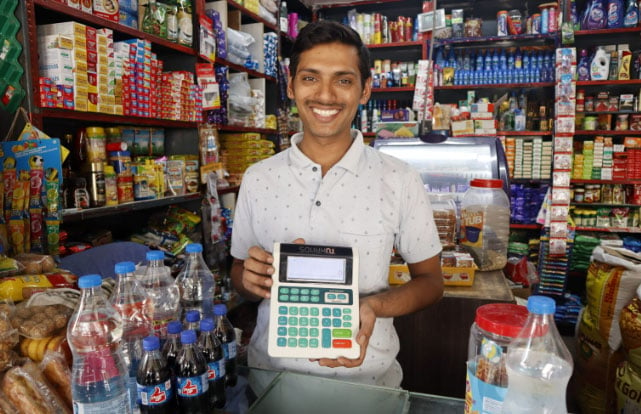
Shanmugavadivel S, founder of IcOnt Technologies and co-founder of Tohands is an electronics enthusiast. He is always open to making his hands dirty with soldering and his hobby is working with electronics. Whenever he finds time, he will do some experiments with electronics that sometimes he too doesn't know what he is doing. Recently, he has unveiled the first of its kind Made-in-India Smart Calculator, which he thinks is the backbone of small businesses. In this regard, let’s find out more about his journey, the challenges he faced during unveiling the device, and what he thinks about the current electronics industry in India
Q. Can you please highlight how your journey as an embedded hardware engineer has been so far?
After my graduation I worked with a few companies in the IoT field, but after a certain point of time I felt bored with doing the same stuff 100 times. Hence, I left the job and did some freelance work. Through freelance work, I gained a few customers. In 2017, I started my company IcOnT. After that we worked with clients majorly in the banking sector for energy measurement and alarm Security systems. At 2021, I joined as a hardware engineer and Co-founder, heading complete product development and production. So, we are doing good and heading towards wonderful new development.
Q. IcOnT Technologies provides End to End solutions from Idea validation to Production, what according to you are the skillsets required to take a product from Ideation to production?
The first and foremost skill should be differentiating theoretical and practical possibilities.
When someone asks for product development and lets you know the idea your mind should have the capability for having possible solutions. This is how you can convince your client and take up the project. This comes once you get some in-depth experience in the field. In-depth field knowledge is required before taking the embedded job,but there's no need to be a master in all that you need. In electronics, solutions can be provided in multiple ways but we need to understand which are the best suitable solutions with optimum results and reasonable pricing of the end product and many more. To be noted, idea validation can be done many ways. But Production requires stringent control over the prices and production time.
![]()
Q. As an Engineer, what are the challenges that you face during the prototype stage? How do you go about with sourcing the components?
People think prototyping is easy. It is the crucial phase where you can make your product whether it will work for your idea or not. But we should know that the first and foremost part is the one which is going to evaluate. The hardest truth to accept is prototyping is easy. In electronics many think that Prototyping is designing hardware boards. There is lots of work involved in making a prototype. For example, we need to plan the shape of the product , size of the product aesthetics, and ease of using the product. We all had this supply chain issue during covid, but we planned in advance and we stocked the material that is needed for our next one product production run. So, we can't struggle with component shortage.
Q. When building a consumer grade prototype, apart from the electronics there are many other things to focus on. Like the external enclosure, aesthetics and presentability. When building in low volume how do you handle this?
To build consumer grade electronics, we need to think in terms of the consumers. What if I was a consumer of that product? What can I do with it or test with? Designers should have that mind perspective. You can’t give the consumer electronic products like industrial products. In consumer electronics, no one cares about the things inside the product. They care about how it looks outside, how beautiful the product is !! Outer body of the product is the first and foremost thing that attracts the consumer and we need to make sure the first impression is the best impression. Manufacturing in low volume will be a key challenge, but it will make you understand how your product really works in the market and any issues there can be fixed easily at the ground level itself. In our case, we build the outer skeleton of the product and test it to see if it can work for our idea or not. Then we work on complete product development from board bring up to enclosure development.
Q. You have recently unleashed the first of its kind smart calculator in the country for small businesses. Can you take us through that journey, what challenges did you face when building it and how did you overcome them?
The journey we did in Smart calculator development so far is insane. We just started with very basic idea validation through the RPI board one and half years back. But unfortunately we don't have enough funds to get involved in full fledged product development. We growed very slowly.
In April 2022 we got selected for Startup india Seedfund. We received the fund in July 2022. From there we started our race. We worked 18 hours a day, 30 days a month, and many more sacrifices. Our ultimate target is we need to launch the product on 26 September 2022. We made 45 revisions of hardware, 3 versions of enclosures, and multiple firmware optimizations. All these things have been done within three months of time. But it's not just about making a working prototype we made it as a consumer grade electronic device. Meantime, we found the right manufacturing partners and supply chain that will ensure our production to be continuous. We will be having an inventory of 500 calculators in January first week of 2023, while we have already fulfilled 35 preorders. The major key challenges we faced is finding a good manufacturing partner and quality of the service with reasonable cost. The supply chain of display is a major trouble we face. Apart from these, there are many hurdles like screen printing with optimal quality and consistent timeline for long term partnerships.
Q. Can you please highlight the product’s uniqueness and what are the kind of new technologies linked with this device?
The Smart Calculator works like a normal casio accounting calculator, that can record sales and expenses of the shopkeeper and syncs the mobile app. The shopkeeper can keep record of their transactions either sale or expense in a calculator and sync with mobile app and export statements on day, week or month basis and have complete analytics over the app. The calculator has a monochrome graphics display that can display anything from text to numbers and even QR codes. It has inbuilt memory that has capacity to store 50 Lakhs transaction entries. The calculator has a rechargeable battery, and can be recharged with a Normal Type Cconnector. The device can get updated features through OTA update. The device has Wi-Fi connectivity along with BLE, that can transmit data to the cloud securely. We are working to implement Dynamic QR which generates payment QR for UPI.

Q. You have been associated with the electrical and electronics manufacturing industry for quite a long time. In this regard, what have you witnessed the biggest changes in the sector in the past few years? Also if you can kindly highlight the current challenges associated with the industry in India and other developed countries?
I feel lots of changes have happened in the industry probably this 5 to 6 years. Many companies started building hardwares and launching their own products. Under Make in India, more products have been manufactured in India which is a good opportunity for electronics manufacturing companies to emerge. The major change I feel is the supply chain of electronics and the presence of n-number of sources or suppliers makes manufacturing much easier compared to 5 to 6 years ago. Key advantage of presence of a number of suppliers gives us the opportunity to negotiate price and continuous supply of raw materials for higher demand. Also many companies are unveiling their own chips which makes the embedded product development companies to have wide options. The major key challenge is getting the latest gen chips from leading companies and they don't have good supply-chains in the Indian subcontinent. That need to be wide opened in indian market so new products will emerged with current gen chips
Q. What are the various kinds of products and solutions IcOnT Technologies offers to the country? Anything unique other than the smart calculator you are aiming to unveil soon?
IcOnT is an OEM design and manufacturing company. We provide a wide range of solutions in electronics systems from industrial automation, IIOT, Embedded hardware development, and other Power Line Products. Our major OEM supply is to the banking security and alarm system company. We are the OEM supplier for a leading banking security company in the North. We are also an OEM supplier for the custom energy measurement systems banking industry. Apart from this we do hardware and firmware development for customer needs, work on new product ideas and bring them to market. Apart from Smart Calculator, We are working on Portable multi volt power back supply for Embedded engineers and general purpose applications.
Q. What are the various kinds of hardware and technologies you are currently working on? Is there anything that you would recommend as a must learn for upcoming engineers?
We are working with all leading MCU and MPUs and working majorly with ST and Espressif socs. In Terms of power electronics, we are working with TI chipsets, maxim, analog devices and many more. In terms of Software tech, we are working with major cloud services including oracle, AWS, Azure, Google Cloud GCP.
I foresee Automations and Power electronics have huge scope in upcoming years. Engineers should sharpen their skills in these fields. Not only theoretical, but hands-on experience is a must to shine in their career. My advice will be if you need to be a star in your career, learn your core field to the core. Then have overall outline knowledge of the stuff related to your field. You can't sustain for long in the industry only with your core subject knowledge. This was the skill lagging among most engineers.

